Women in ITE - Blog
Each month we will explore a new topic that contributes to safe, equal opportunities in the transportation profession and the communities we serve. The sidebar shows a tentative schedule for topics
Monthly Topics
- December 2024
Holiday Sing-a-Long - November 2024
Preventing Burnout with Self Awareness - October 2024
Interview with Mariel Colman, P.E., AICP, Senior Engineer and Planner, Toole Design - September 2024
The Power of Mentorship: Why You Should Get Involved - August 2024
Celebrating 30 Years of Trailblazing Leadership: Honoring Marsha Anderson Bomar, Ph.D., AICP, Eng SP, F. ASCE, (H) - July 2024
Have A Summer of Fun! - June 2024
Welcome to Philadelphia! Preview of #ITEPhilly2024 - May 2024
Battling Burnout - April 2024
You have secured an internship… but, now what? - March 2024
Ethics and Your License - February 2024
Age Is Just A Number, Until That Number Becomes Ageism - January 2024
Transforming Awareness to Action: Fighting to End Human Trafficking - All 2023 Blogs
- All 2022 Blogs
- All 2021 Blogs
- All 2020 Blogs
- All 2019 Blogs
I joined this committee when I realized we could make a difference – so much great work is out there. -Jen Malzer, Canadian District
I joined this committee because I remember being the only female engineer in many settings early in my career. I was fortunate enough to have great mentors surrounding and supporting me. I want to help other engineers have the same level of confidence that I was able to experiences. - Angela Garland, PE, PTOE, Pennoni
Holiday Sing-a-Long
The 2024 Women in ITE Committee wants to wish you and your family happy holidays. From monthly blogs on special industry topics to hosting boot camps for more in-depth conversations, our committee has worked hard throughout 2024 to bring ITE members extra resources. Ending the year on a festive note, we wanted to send you our holiday video card with a transportation-inspired carol remix to celebrate the faces behind our committee. Please sing along with the lyrics below.
After all, It's the Most Wonderful Time of the Year!
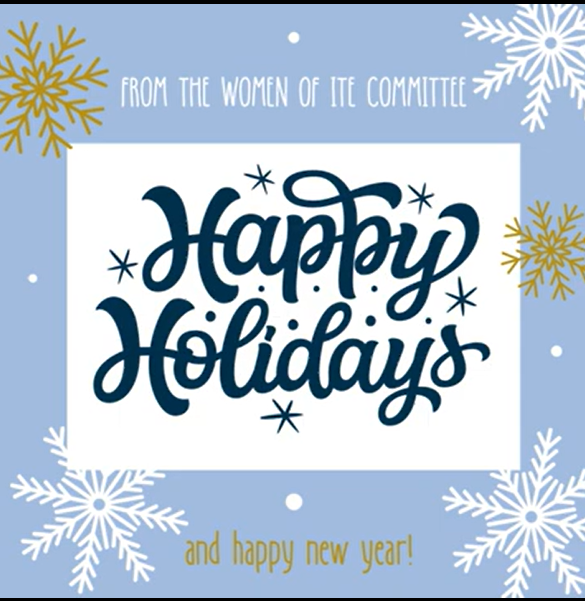
(click the above image for the soundtrack for the season)
Sing-A-Long Remix
It's the most wonderful time of the year,
With cars gently slowing,
And everyone saying, "Drive safe and take care!"
It's the most wonderful time of the year!
It's the hap-happiest season of all,
With safe driving greetings and caution not speeding,
Slow down, heed the call
It’s the hap-happiest season of all!
There'll be parties for hosting,
Be careful when toasting,
A rideshare is the smartest call
There'll be warnings for texting,
And tips for protecting,
To keep us all safe on the road!
It's the most wonderful time of the year
The roads will be crowded and drivers distracted
please travel with care,
It's the most wonderful time of the year!
It's the most wonderful time of the year
Don’t hurry, no worries, leave sooner, drive slower
Just drive, stay alive!
It's the most wonderful time,
Yes, the most wonderful time,
Oh, the most wonderful time of the year!
Preventing Burnout with Self Awareness
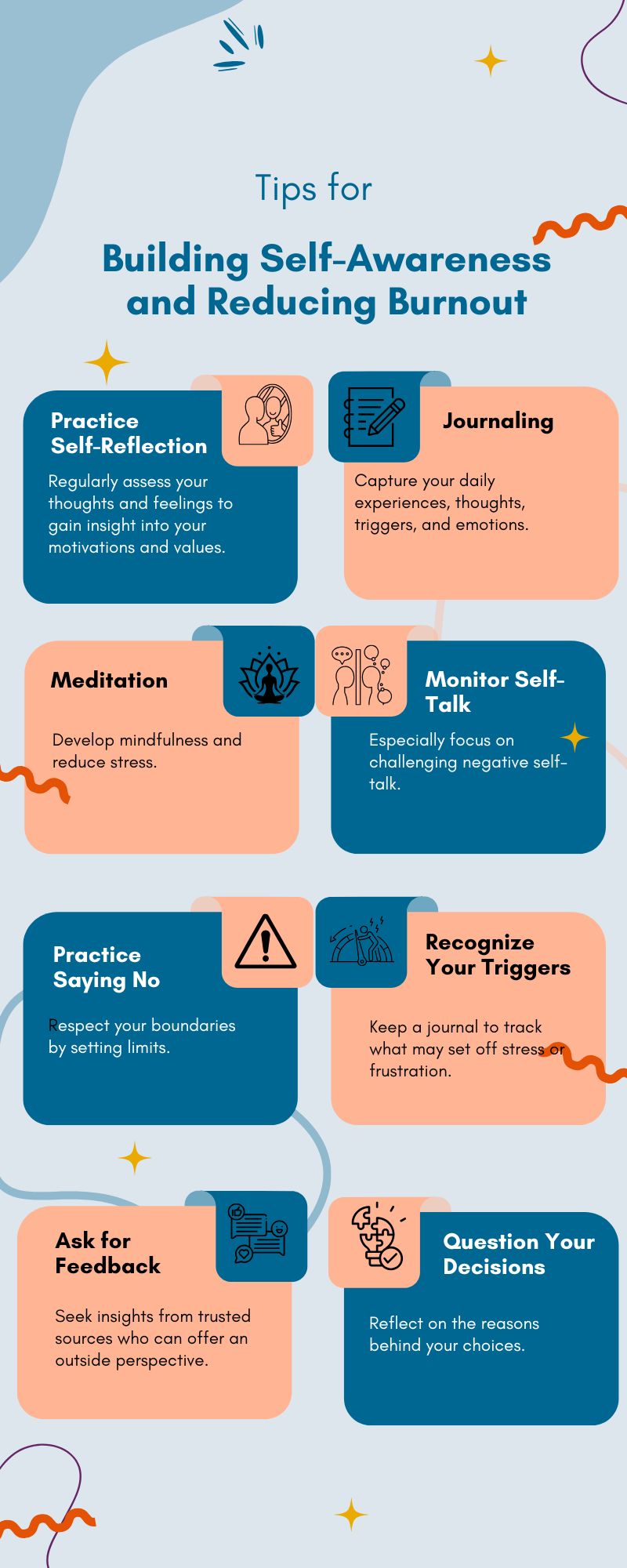 I’ve experienced burnout up close and felt its impact. It led me to question whether I truly belonged in the transportation field and whether I had what it took to “make it” in this fast-paced industry. I waited too long to address my burnout, and by the time I took action, I had to work especially hard to restore (relative) balance in my life. Along the way, I learned a lot about myself—my triggers, my boundaries, and how far I can push myself without compromising my well-being.
I’ve experienced burnout up close and felt its impact. It led me to question whether I truly belonged in the transportation field and whether I had what it took to “make it” in this fast-paced industry. I waited too long to address my burnout, and by the time I took action, I had to work especially hard to restore (relative) balance in my life. Along the way, I learned a lot about myself—my triggers, my boundaries, and how far I can push myself without compromising my well-being.
There are many tools in the “Avoiding Burnout” toolbox, but these tools only work if you know when and how to use them in a way that benefits you personally. When I began my burnout recovery, I made small changes and observed if they improved my happiness and productivity. If a strategy worked, I kept it; if it didn’t, I moved on to something new. Over time, I found myself thriving again. I was able to “do more in less time,” and I felt more creative and inspired than ever. It was a fantastic feeling.
I know I’m not alone in experiencing burnout. Mental health challenges are at an all-time high, and many in the transportation industry face burnout and related challenges daily. This industry is known for its high-stress, fast-paced roles, where the to-do list seems endless. Yet, when we’re not functioning at our best, we lose productivity, creativity, and satisfaction in our work.
One of the most important tools I discovered is self-awareness. With strong self-awareness, we can recognize stress early and make changes before it escalates to burnout. Self-awareness allows us to monitor our behaviors and emotions, keeping us grounded and attuned to our needs. Here are some powerful tools that can help build self-awareness:
• Practice Self-Reflection: Regularly assess your thoughts and feelings to gain insight into your motivations and values.
• Journaling: Capture your daily experiences, thoughts, triggers, and emotions.
• Meditation: Develop mindfulness and reduce stress.
• Monitor Self-Talk: Especially focus on challenging negative self-talk.
• Practice Saying No: Respect your boundaries by setting limits.
• Recognize Your Triggers: Keep a journal to track what may set off stress or frustration.
• Ask for Feedback: Seek insights from trusted sources who can offer an outside perspective.
• Question Your Decisions: Reflect on the reasons behind your choices.
Remember, not every tool works for everyone, and that’s okay. With practice, you can identify which tools help you best understand yourself. If you’re struggling with burnout or any mental health challenge, reach out to someone you trust. Taking that first step can make all the difference. In you need further resources, please consider:
• Mental Health America | Homepage | Mental Health America
• Anxiety and Depression Association of America, ADAA | Anxiety and Depression Association of America, ADAA
Women in ITE has previously hosted a webinar on Burnout. A link to that event can be found here: Beyond Bandages: Battling Burnout with Women in ITE -Webinar (May 21st 2024)
Interview with Mariel Colman, P.E., AICP, Senior Engineer and Planner, Toole Design
October is the National Pedestrian Safety Month, as well as Walk & Roll to School Day (October 9, 2024) and the School Bus Safety Week (October 21-25, 2024). Road Safety Week 2024 is just around the corner (November 18-24, 2024). There is, thankfully, an increased focused on safety in today’s transportation practice: Road Safety Audits, Safety Action Plans, Vision Zero, Safe System Approach, the Highway Safety Improvement Program, and more. And if you are active in safety evaluation, you know a frequent target of these efforts are four- and five-lane arterials in our urban and suburban areas. So this month the Women in ITE are highlighting an interview with Mariel Colman, P.E., AICP who provided some excellent context on multi-lane undivided highways in urban and suburban areas, and how roadway designers can change their approach to help reduce risks for the traveling public.
INTERVIEWER: Five-lane roads are all over U.S. cities and suburbs. Are they necessary?
MARIEL: No, many of them are not necessary. Much of the roadway infrastructure throughout the United States has been built (or overbuilt) to carry vastly more traffic than it actually does. According to the FHWA, “Typically, a Road Diet is implemented on a roadway with a current and future average daily traffic of 25,000 or less.” In Ohio, where I live and work, of the 44,000 miles of roadways with more than three lanes, 95% have an annual average daily volume of fewer than 25,000 vehicles, and 80% are under 15,000 vehicles per day. So even by today’s engineering standards, there is no reason these roadways need so many lanes, and certainly no excuse to further widen them.
INTERVIEWER: Why are wide roads and excess capacity a problem?
MARIEL: For starters, they’re a problem because they’re not safe. Wide, fast roads in populated areas are at the center of the roadway safety crisis. Yet many cities and states continue to push forward with “safety improvement” projects that involve road widening. I’m not singling out any one area of the country here; nearly every jurisdiction in the U.S. historically used the same playbook and principles that prioritized speed over safety. Today, many of those same cities and states are now striving for a safer, multimodal transportation network.
There is a body of evidence that shows wider lanes and excess roadway capacity lead to higher speeds. And speed kills. Adding travel lanes on roadways with intersections and access points means left-turning drivers have more lanes to cross. That exposes them to more potential left-hook crashes. And, since wider roads lead to higher speeds, it means those crashes are often deadlier.
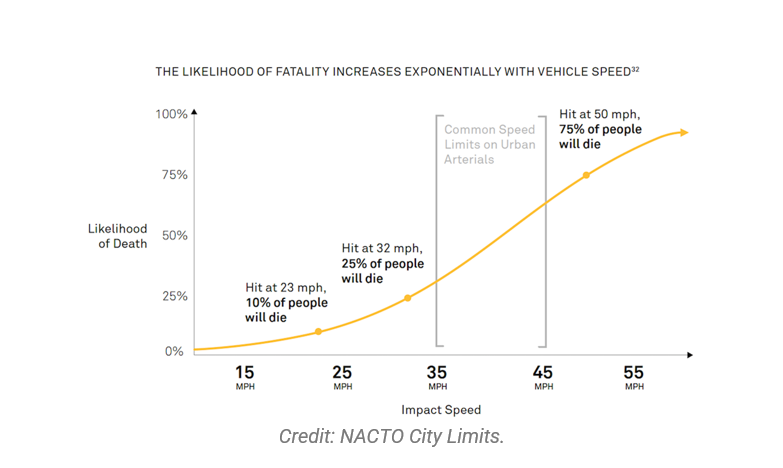
Adding lanes also leads to greater exposure for people walking, biking, or rolling at intersections and crossings. This is because they have a wider roadway to cross but also because drivers need to pay attention to multiple lanes of oncoming traffic and therefore are more likely to overlook a person crossing. If we want to get serious about systemic safety, we need to design roads that invite slower speeds and are less likely to lead to fatal or serious injuries when collisions do occur.
INTERVIEWER: Who are these roads harming?
MARIEL: Multi-lane roadways with excess capacity perpetuate inequities in the United States. Their safety risks disproportionately harm Native American people, Black people, young people, older people, people with disabilities, unhoused people, and people from low-income households. These wide roadways with fast-moving traffic (and often minimal or no sidewalks) are more likely to occur in areas of poverty and low-wage employment. And people living and working there often lack political capital to successfully stop the construction or expansion of these dangerous corridors.
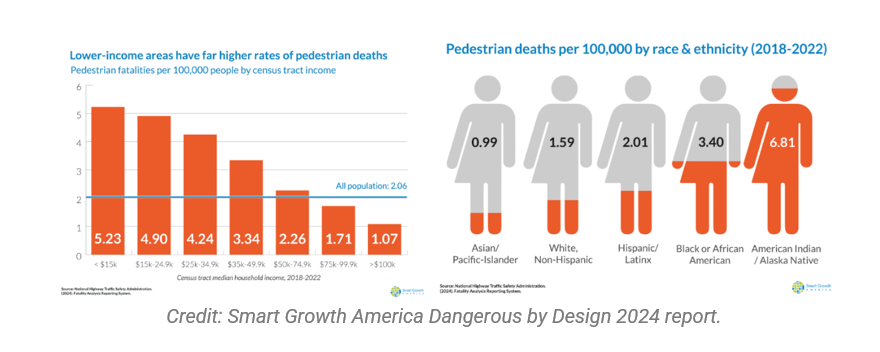
People in these areas are also less likely to benefit from a roadway designed to move cars faster, as rates of vehicle ownership are lower. Those who depend on walking, biking, or taking transit face longer crossing distances and wait times, and a high risk of exposure. These areas have effectively been deemed “flyover” zones for those with motor vehicles to pass through. And the deaths and injuries of people living and working there are the collateral damage.
INTERVIEWER: Are unsafe, inequitable roadways the price we pay for efficiency?
MARIEL: Fast-moving, multi-lane roads aren’t actually efficient. Most traffic studies focus on capacity, meaning how to move the most people in the least amount of time. But if capacity is the goal, then why are we prioritizing the least efficient mode to accomplish that goal?
Looking at the big picture, motor vehicles simply don’t move people as efficiently as other modes. We’ve all seen some version of the graphic showing how many more person-trips we can accomplish by walking, biking, or transit than by single-occupancy vehicles. Even when optimistically maxed out with 4-5 people, private vehicles can’t match the carrying capacity of shared, active, or mixed modes. If we want to build roadways that move people efficiently, let’s design them to support the most efficient modes.
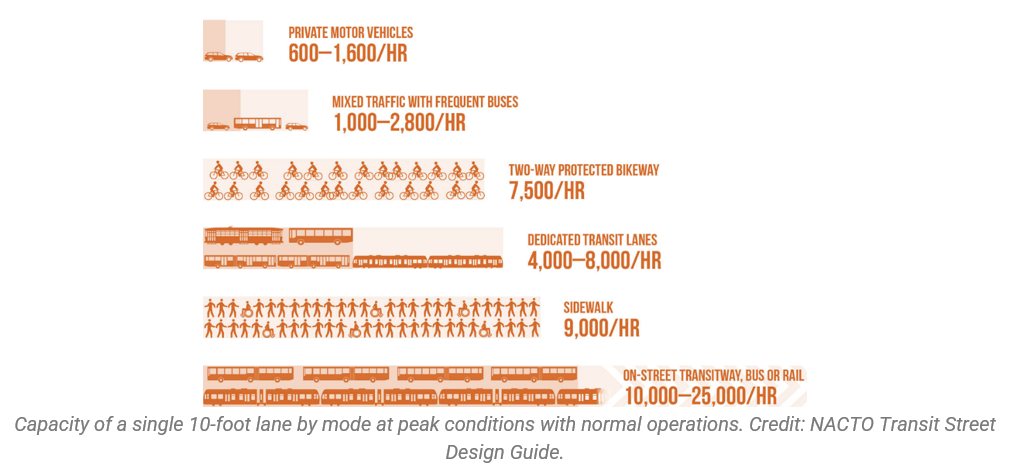
I’ll also note that wide streets that prioritize motor vehicles are not an efficient use of land or of public funds. Check out Strong Towns’ article The True Cost of a Stroad for a good summary of this point.
INTERVIEWER: How can engineers be part of the solution?
MARIEL: In some ways, engineers are the gatekeepers of roadway design, with our codes and equations and traffic forecasting models. We have a “certified” way of predicting future traffic volumes. At the same time, I know many engineers feel trapped by these tools. I often hear things like, “We want to change what we’re doing but don’t know how.” Or “Our standards just don’t allow us to do this differently.”
Traffic forecasting is a self-fulfilling prophecy: by designing for more cars, we end up encouraging more driving. It’s a cycle based on a false assumption. More cars do not necessarily warrant more roadway space. And, crucially, more people does not necessarily mean more cars.
There is another way. What if we repurposed the extra space in the roadway for transit and bikeways? What if, instead of perpetuating inequities, we designed for modal equity, safety, and community and economic vitality?

INTERVIEWER: Sounds great! How do we do that? How do we break the cycle?
MARIEL: We need to change our assumptions. We’ve already proven for decades that the assumptions we feed the model will yield results in line with those assumptions. Let’s stop clinging to outdated models that assume growth equals more cars and wider roadways. Instead, we should pledge to accommodate growth with a maximum of, say, three vehicular lanes AND high-quality pedestrian, bicycle, and transit infrastructure. We can change the equation, like Colorado is doing, and change the outcomes.
We also need to consider movement and place. Instead of starting with site selection and considering transportation needs later, we can help integrate transportation and land use decisions. I look to FHWA’s Improving Pedestrian Safety on Urban Arterials: Learning from Australasia, which outlines the Movement and Place framework used in Australasian countries and emphasizes the need for teams — including engineers — to work together to coordinate a community’s vision for transportation (movement) and land use (place), whether on a narrow city street or a higher-speed arterial.
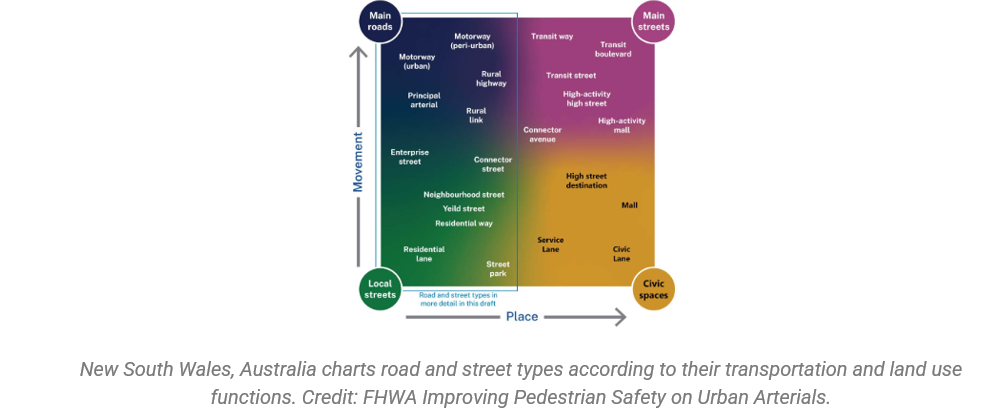
INTERVIEWER: Do you see these changes starting to happen?
MARIEL: Thankfully, yes. Some states and communities are already taking these steps in heartening ways. For instance, the Northwest Ohio SS4A Plan features engineering and land use policies that prioritize safe access and mobility for all.
I’m really proud to work with many safety-first and people-focused engineers, both at Toole Design and in communities across the United States. We have the opportunity to rethink the standards and assumptions we have inherited to engineer a safer, more efficient, more equitable transportation future.
 Mariel Colman is a Senior Engineer and planner in Toole Design’s Columbus, OH office. During her undergraduate studies in civil and environmental engineering, she quickly realized she wanted to be an engineer who prioritized people and their environments. She went on to earn a Master of City and Regional Planning and a Master of Science with a focus in multimodal transportation planning and design. Mariel brings both a design perspective and attention to community values to her work. Her experience includes multimodal and green infrastructure design, design guidance and trainings, corridor planning, and safety studies.
Mariel Colman is a Senior Engineer and planner in Toole Design’s Columbus, OH office. During her undergraduate studies in civil and environmental engineering, she quickly realized she wanted to be an engineer who prioritized people and their environments. She went on to earn a Master of City and Regional Planning and a Master of Science with a focus in multimodal transportation planning and design. Mariel brings both a design perspective and attention to community values to her work. Her experience includes multimodal and green infrastructure design, design guidance and trainings, corridor planning, and safety studies.
The Power of Mentorship: Why You Should Get Involved
Imagine you’re a student or a young professional who starts to consider transportation as your career. You’re excited about your first transportation job, but as time goes on, you start to feel a bit lost. You have questions about your career path, the skills you need to develop, and how to navigate the professional landscape. You’ve heard about the value of networking but aren’t sure where to start. This is the perfect moment to seek out a mentor—someone who has walked the path before you and can provide guidance, support, and insight into the industry.
Now, consider another scenario: You’ve been in the transportation industry for several years and have developed a wealth of knowledge and experience. You’ve successfully navigated your career, built a strong professional network, and now you want to give back to the community that has supported you. You want to help others find their way and share the lessons you’ve learned along the way. Becoming a mentor offers a rewarding opportunity to pass on your knowledge, gain new perspectives, and contribute to the growth of the profession.
Mentorship is a powerful tool that offers tremendous benefits, both for mentors and mentees, in the transportation profession. The beauty of mentorship is its flexibility—it can be tailored to fit busy schedules and varying needs. Whether it’s a virtual meeting, an in-person coffee chat, or a quick office hour session, mentorship doesn’t have to be a long-term commitment. You can connect once a month for 30 minutes or even just occasionally at conferences or happy hours. The most important step is to start—initiate the process and watch how it can transform your career and personal growth.
My In-Person Mentorship Experience through ITE Local Section
From 2019 to 2022, I had the privilege of being mentored by Dr. Beverly Kuhn (2022 International President of ITE) through the Brazos Valley section. Dr. Kuhn was not only my mentor but also was my division head when we both worked at the Texas A&M Transportation Institute. Around the time she started her vice-presidential campaign in ITE, we began scheduling regular coffee chats to discuss career development and her visions for ITE and for her Transportation Research Board (TRB) Freeway Operations committee. Her strategic thinking and willingness to share her vast knowledge were instrumental in shaping my career. Dr. Kuhn encouraged me to get involved in professional committees within ITE and TRB, which significantly broadened my professional network and exposure. As a female leader in the transportation field, she has been a role model, generously sharing her life and professional experiences, and helping young engineers like me navigate the complexities of the profession.
My Virtual Mentorship Experience through ITE e-Community
In 2020, during the height of the COVID-19 pandemic, networking and professional development became challenging. That’s when I turned to ITE’s Mentor Match program through their e-Community platform. This program connects mentees with mentors across the nation, offering short, medium, or long-term mentorship relationships based on individual preferences. I was fortunate to be paired with Dr. Peter Savolainen (recipient of the 2024 Council Impact Award from ITE), who guided me through discussions on career paths in both academia and industry. Our virtual mentorship sessions were focused on the evolving trends in transportation technology and practical research applications. Despite the virtual nature of our interactions, the bond we formed has extended beyond that one-year period. Since 2021, I have continued to support Dr. Savolainen’s work with the ITE Education Council, demonstrating how mentorship can grow into a lasting professional relationship.
Taking the Next Step
Inspired by the positive impact that mentorship has had on my career, I plan to enroll as a mentor in ITE’s Mentor Match program for FY 2025. I encourage all transportation professionals, whether early in their careers or seasoned experts, to consider participating in a mentorship program. It’s a valuable benefit of your ITE membership, offering the chance to both give and receive guidance in our field. If you’re interested in mentoring, I invite you to explore the ITE Mentor Match program or other mentorship opportunities through ITE. Together, we can continue to support and uplift the next generation of transportation professionals.
Celebrating 30 Years of Trailblazing Leadership: Honoring Marsha Anderson Bomar, Ph.D., AICP, Eng SP, F. ASCE, (H)
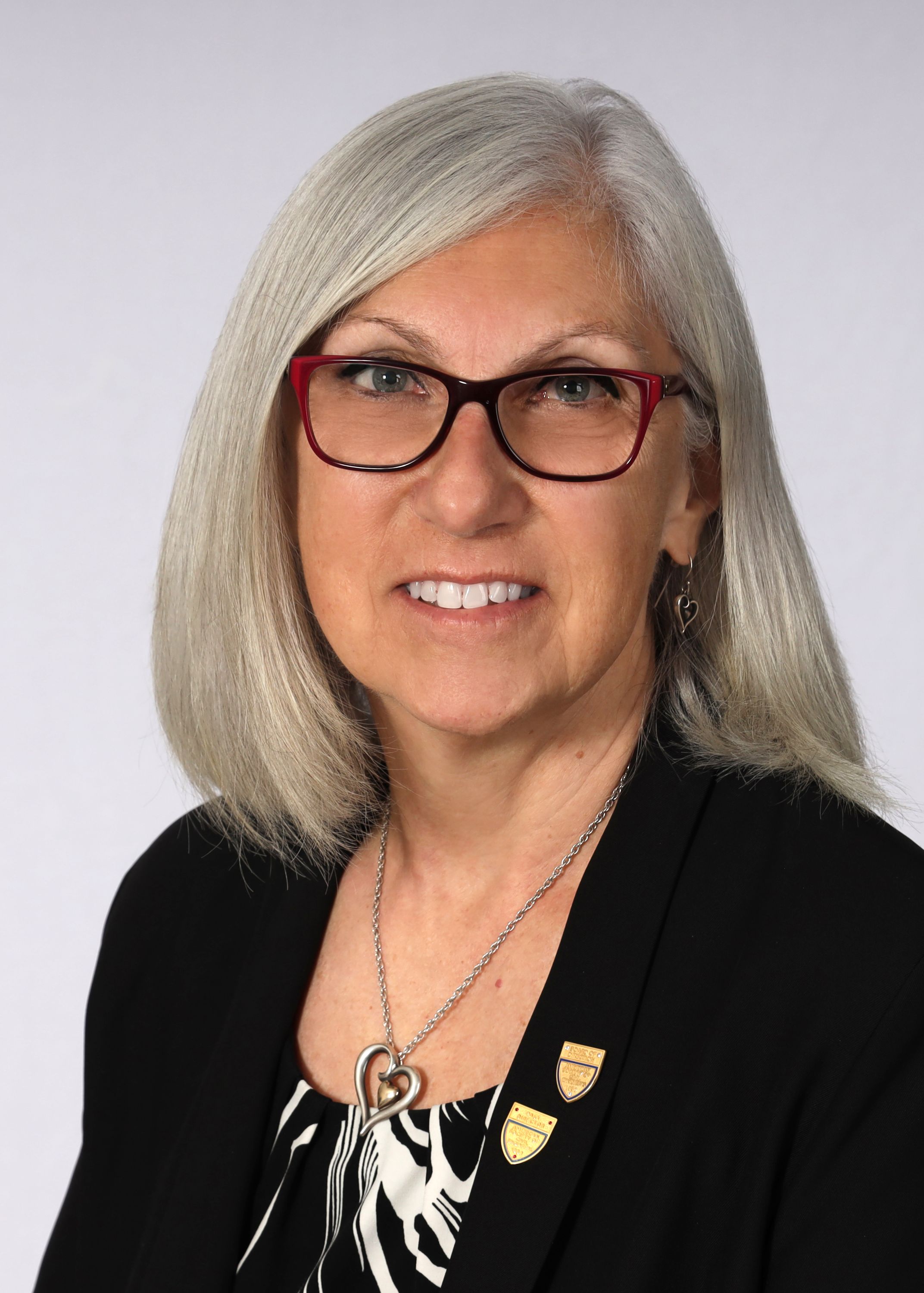 In the world of transportation engineering, Marsha Anderson Bomar's name shines brightly. As we commemorate the 30th anniversary of her historic election as the first woman president of the Institute of Transportation Engineers (ITE), we celebrate not only her remarkable achievements but also the profound impact she has had on countless lives and the profession itself.
In the world of transportation engineering, Marsha Anderson Bomar's name shines brightly. As we commemorate the 30th anniversary of her historic election as the first woman president of the Institute of Transportation Engineers (ITE), we celebrate not only her remarkable achievements but also the profound impact she has had on countless lives and the profession itself.
If you haven't met Marsha just yet: Meet Marsha, a true trailblazer and an incredible inspiration to all who know her. Marsha's impact on the world is nothing short of legendary. She's not just any leader—she's the first woman to serve as the International ITE President, a role she took on 30 years ago! Today, she continues to lead as the ASCE Vice President Elect and is a founding pioneer of the Women in ITE Committee.
Marsha's credentials are impressive: a Ph.D., a planner, an honorary member of ITE, a fellow of ASCE, and a devoted mother, wife, and mentor. But beyond the titles and accolades, Marsha is the kind of friend who makes you feel invincible. She's always there, whether you're celebrating a win or navigating life's missteps, offering support, strategy, and a comforting hug. Her ability to change lives is remarkable. Marsha sees herself as the lucky one, but truly, we are all blessed to have her energy, guidance, and empathy in our lives. We invite you to continue reading and discover the incredible impact Marsha has had in the transportation profession.
Have A Summer of Fun!
With summer well under way we thought it might be fun to give some summer activity ideas! We tried to compile a variety of activities for all ages! Enjoy!
Outdoor Activities
 Don’t forget to plan and check the weather, wear appropriate gear, use sunscreen, apply bug spray, don’t leave your trash behind, be smart when building a campfire and extinguish it thoroughly and always respect wildlife!
Don’t forget to plan and check the weather, wear appropriate gear, use sunscreen, apply bug spray, don’t leave your trash behind, be smart when building a campfire and extinguish it thoroughly and always respect wildlife!
- Go on a hike
- Go fishing
- Backyard birding is an easy and delightful activity for all ages! Do you know the call of a red-winged blackbird or a mourning dove? Can you tell a duck from a grebe? No worries! Apps like Merlin are here to help you ID birds through sound or easy walk throughs - you don't need to be chasing rare birds to delight in these creatures we share our spaces with. Merlin Bird ID – Free, instant bird identification help and guide for thousands of birds – Identify the birds you see (allaboutbirds.org)
- Pack a picnic lunch and blanket and head to your local park (or even just your own backyard) and enjoy a meal "al fresco". You can even make it a fancy lunch will little tea sandwiches and homemade lemonade or sweet tea.
- Check out the Questo App for local events: Events | Questo (questoapp.com)
- Find a Pick-Your-Own farm for Blueberries, Strawberries, Blackberries, etc. Grab your own bucket and head out to pick until your heart’s content.
- Organize a nature scavenger hunt. Create a list of items you might find outside, then head out for a nature scavenger hunt. For little ones, use pictures of birds, flowers, bugs, clouds, etc. and give them a crayon and clipboard to start marking things off as they find them. Older kids will appreciate more of a challenge – locating things such as specific tree types, certain kinds of colored flowers, bugs, etc.
Sports and Fitness
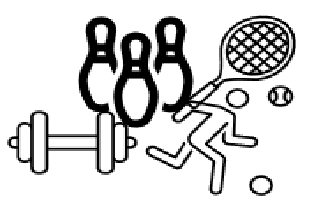 According to the CDC (Benefits of Physical Activity | Physical Activity Basics | CDC) benefits of physical activity include weight management, reduction of health risks, strengthen bones and muscles, may increase you chances of a longer life, and helps to manage chronic health conditions & disabilities.
According to the CDC (Benefits of Physical Activity | Physical Activity Basics | CDC) benefits of physical activity include weight management, reduction of health risks, strengthen bones and muscles, may increase you chances of a longer life, and helps to manage chronic health conditions & disabilities.
- Kayaking on the river is fantastic! Kayaking Florida’s Weeki Wachee River | VISIT FLORIDA or Kayaking Near Me - Canoeing Near Me - Locations Map | Paddling.com
- Take a morning or evening walk with family or a friend; since schools aren't in session, utilize track availability at local public schools when sports teams aren't using them
- Planet Fitness Teen Summer Pass (Free Summer Gym Membership for Students | Planet Fitness)
- Biking
- Yoga
- Kickball
- Pickleball
- Bowling
- Laser Tag
- Performance Health also has some great ideas for fun activities! 20 Family Fitness Ideas Beyond the Gym | Performance Health
Travel Ideas
 Hit the road for a short day-trip or a longer road trip. If you're planning on taking a road trip this summer, consider taking the long way to your destination so you can detour to some fun or historical place. Make sure to plan this out in advance to decide where you want to stay and eat and to make sure you know the business hours of wherever it is you are visiting. If traveling with kids, check out Yelp to help you find family-friendly places. Here are some other ideas:
Hit the road for a short day-trip or a longer road trip. If you're planning on taking a road trip this summer, consider taking the long way to your destination so you can detour to some fun or historical place. Make sure to plan this out in advance to decide where you want to stay and eat and to make sure you know the business hours of wherever it is you are visiting. If traveling with kids, check out Yelp to help you find family-friendly places. Here are some other ideas:
- International travel – Alaska, New Zealand, Scotland, England, maybe somewhere from your ancestry
- Take a cruise! Disney Cruise is always a fun one for kids
- Amusement parks: The 19 Best Amusement Parks in the U.S. for 2024 (usnews.com)
- National Parks NPS.gov Homepage (U.S. National Park Service)
- Visit new states
- Visit your favorite MLB team by visiting other stadiums
- Santa Cruz/Day at the beach!
- Think about museums, nearby cities, water parks, etc. nearby or within a few hours
- Search for daytrip ideas on the internet Visit A City: Create Your Personal Travel Guide
Backyard/Staycation Ideas
 It’s always fun to host a party…. make it even better with a theme! Some tips to a successful party (11 Insanely Smart Ideas for Your Backyard Party | Taste of Home) include prep early, have extra seats, provide simple DIY activities, have a cooler or two handy with ice, serve with speed using both sides of a buffet table, create a summer soundtrack for nonstop music fun, and pre-hang lights for nighttime fun!
It’s always fun to host a party…. make it even better with a theme! Some tips to a successful party (11 Insanely Smart Ideas for Your Backyard Party | Taste of Home) include prep early, have extra seats, provide simple DIY activities, have a cooler or two handy with ice, serve with speed using both sides of a buffet table, create a summer soundtrack for nonstop music fun, and pre-hang lights for nighttime fun!
- Murder Mystery Party: Downloadable Murder Mystery Party Games | Night of Mystery
- Host an Outdoor Movie Night: How to Host a Backyard Movie Night - The Home Depot
- Summer Olympics watch party! Everyone dresses up to support their favorite sport or home country
- Hawaiian theme or pirate theme; scary and/or action/thriller (Alfred Hitchcock) movies
- This is the best recipe (for meat eaters) for party food - simple to make, incredibly delicious, and you can do all the work the day before and it only gets better in the fridge! Pork Adobo Pull-Apart Sliders Recipe | Bon Appétit (bonappetit.com)
- Come up with themed meals to eat while watching your favorite movie (i.e. Movie-Themed Dinner Menu Ideas | POPSUGAR Food)
- Host a "Drinks on the Drive/way" event in your front yard to welcome new neighbors and to meet new people in the neighborhood.
- Host a cornhole tournament and charge a small entry fee to cover 1st prize and to raise money for your favorite charity. Request that each team bring their own boards and bags as well as their favorite drinks/snacks to share. Encourage creative team names and create brackets ahead of time. You can even ask a fun friend to emcee/DJ the tournament.
“Outside the Box” Ideas
 Finally, we compiled a few less common ideas.
Finally, we compiled a few less common ideas.
- Painting in the outdoors
- Flower arranging class, DIY flower arranging
- When it's too hot to play outdoors but you don't want your kids to spend all afternoon watching tv, find a directive drawing on YouTube and ask your kids to create some masterpieces. Check out this YouTube channel that has lots of examples: https://www.youtube.com/@artforkidshub
- Volunteer for your local Food Bank Volunteer Opportunities at Your Local Food Bank | Feeding America
- Volunteer at a local humane society Volunteer to help animals | The Humane Society of the United States or your local SPCA (ie.East Bay SPCA: https://eastbayspca.org/)
- Help kiddos host a lemonade stand or garage sale
- Tour the local fire station
- Conduct a cookie exchange with friends. Each person makes a batch of cookies and wraps them individually to swap. Don’t forget to print the recipes on the bags.
- Don't forget to check in with your local libraries and parks departments for activities for all ages! Many will host movie nights and jazz in the parks, for instance.
Welcome to Philadelphia! Preview of #ITEPhilly2024
By Becky Biro and Kate Russo
You might know Philadelphia as Ben Franklin’s hometown, home to many avid sports fans, or the best place to get a cheesesteak, but there is so much more to explore in Philadelphia. In addition to participating in the ITE 2024 International Meeting technical sessions and tours, I encourage you to enjoy all that Philadelphia has to offer. I’ll share a few of my top recommendations for tourist attractions to visit, off the beaten path destinations, and of course, the best places to get a cheesesteak.
Getting Here:
- By Train: Philadelphia is accessible by Amtrak train from most major northeast/mid-Atlantic cities along the I-95 corridor. Amtrak trains arrive at 30th Street Station (30th & Market St), which is located a little over a mile from conference hotel (12th & Market St).
- Insider tip: Amtrak tickets are valid on SEPTA Regional Rail trains within Center City. Transfer at 30th Street Station to SEPTA and take the train two stops to Jefferson Station (12th & Filbert – in front of the hotel). All regional rail trains make this connection, and there’s even a handy display at 30th Street showing you the next train to Center City.
- By Plane: Connections to SEPTA Airport Line Regional Rail trains are located within each terminal of Philadelphia International Airport (PHL). It is a 20-30 minute train ride from PHL to Jefferson Station. Another option would be to take an Uber or Lyft from the airport to the Marriott Downtown - approximately a 20-minute ride but could be longer depending on traffic.
- Driving: Parking at the hotel is available at a cost. Check out the Philadelphia Parking Authority’s App for local garages (www.philapark.org) or Spot Hero (www.spothero.com) to find your garage before you arrive (rates vary a lot between garages by time of day).
- Indego Bikes – Indego Bikes are Philadelphia’s Bike Share – rent them to get around the City (www.rideindego.com).
- SEPTA is Philadelphia’s transit system with buses, trolleys, subways and regional rail – try them all!
Recreation
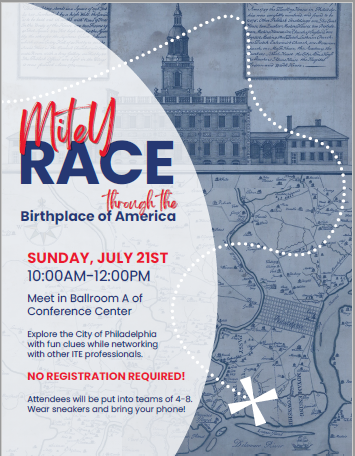 ITE’s Local Arrangements Committee has organized two fun events to help you get to know Philadelphia and get a little exercise:
ITE’s Local Arrangements Committee has organized two fun events to help you get to know Philadelphia and get a little exercise:
- MiteY Race – Sunday (7/21) Morning from 10 am-noon. This is going to be a great way to explore the City and learn some fun facts along the way! You do not need to register in advance.
- Rocky Run – Monday (7/22) Honoring the iconic 1976 movie, meet at 6:30 a.m. for a walk or run to the Art Museum steps and Rocky statue to get a picture and climb the steps. There is no advance registration or fee.
- Check out the Conference App for other exercise recommendations such as yoga, spin or a gym.
Looking to explore on your own? Here are a few of our personal favorite things to do with and without tourist friends:
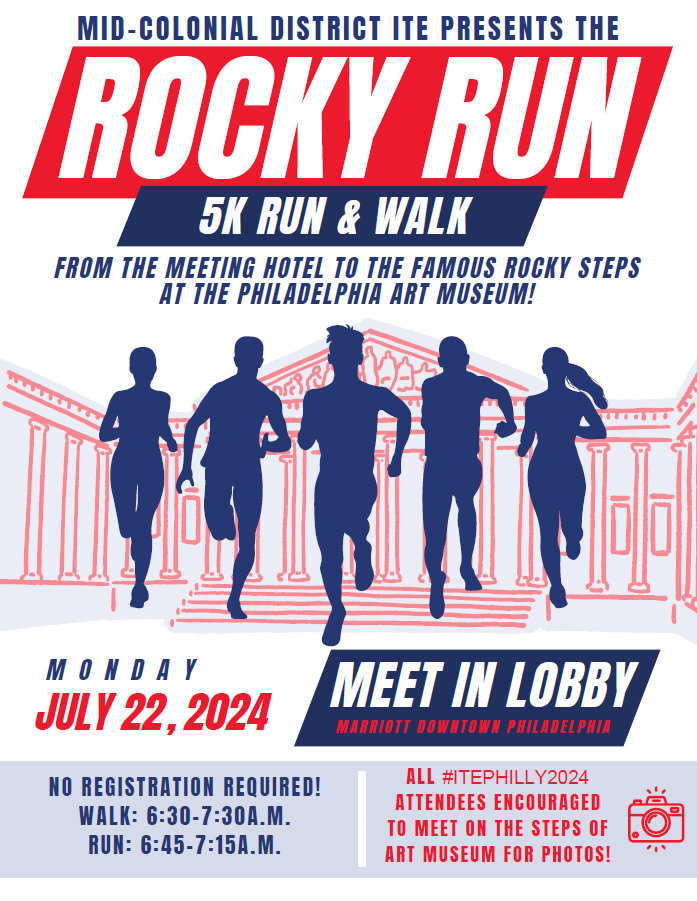 Fairmount Park is the perfect place to start for outdoor activities in Philadelphia. Avid cyclists can enjoy 25 miles of trails connecting center city Philadelphia with Valley Forge National Historic Park, but there are also shorter trails for all ages and ability levels. Check out other park highlights such as Boathouse Row and Forbidden Drive.
Fairmount Park is the perfect place to start for outdoor activities in Philadelphia. Avid cyclists can enjoy 25 miles of trails connecting center city Philadelphia with Valley Forge National Historic Park, but there are also shorter trails for all ages and ability levels. Check out other park highlights such as Boathouse Row and Forbidden Drive.- Spruce Street Harbor Park is a carnival like atmosphere with a ferris wheel, rides and local food vendors while overlooking the Delaware River and the Ben Franklin Bridge.
- City Hall and Love Park – 2 blocks from the conference hotel has a festive outdoor roller skating rink, fountains that you can walk through, food vendors and the iconic LOVE statue available for the perfect selfie.
- Philadelphia Parks & Recreation also has pop-up beer gardens throughout the city www.parksontap.com.
Museums
Philadelphia is well known for its history and many museums. In particular, here a few that you might want to check out during your stay grouped by neighborhood.
- Independence National Historic Park - Take a 15-minute walk or a quick ride on the Market-Frankford Line to explore the founding of America. Visit the National Constitution Center, Independence Hall, the Benjamin Franklin Museum, Congress Hall, the Mint or the Liberty Bell Center.
- Ben Franklin Parkway - Taking a stroll down the Benjamin Franklin Parkway, you’ll pass countless museums that pique the curiosity of all interests and age ranges. Philadelphia Art Museum, Franklin Institute, Academy of Natural Science & Mutter Museum plus lots of parks & parklets are along the way.
- Off the beaten path - Eastern State Penitentiary was once the involuntary home of Al Capone, but today it is a locally renowned historic site where you can follow a self-guided tour of the ruins of the world’s first true “penitentiary” designed to inspire true regret in the heart of its inhabitants.
Cheesesteaks
Check “eating a cheesesteak in Philadelphia” off your bucket list. Here are a few local favorites:
- Pat’s King of Steaks and Gino’s Steaks in South Philly are some of the best known cheesesteak purveyors in Philadelphia. They’re definitely yummy, but many locals think there are better choices.
- Jim’s Steaks on South Street is a local favorite. A little over a mile away from the conference hotel, visitors can enjoy a stroll through several Philadelphia’s neighborhoods en route to Jim’s.
- Spataro’s at Reading Terminal Market may not be #1, but it delivers a solid “Philadelphia worthy” cheesesteak right across the street from the conference hotel.
- If you want to earn your cheesesteak, take an 8-mile bike ride along Kelly Drive / Boat House Row to Manayunk to sample my personal favorite cheesesteak location - Dalessandro’s Steaks in Roxborough / Manayunk.
Restaurants
You should not go hungry in Philadelphia, there are many great restaurants, chefs and restauranteurs within a short walk of the Marriott Downtown that serve a variety of fantastic cuisine other than cheesesteaks. The Reading Terminal Market is directly across the street from the conference hotel and features a host of food vendors covering just about every cuisine you could want. You can’t go wrong when you visit a restaurant owned by Stephen Starr, Marc Vetri, or Jose Garces. Check out the restaurant list available through the conference app or that is up on the website.
For those who are young or young at heart – check out the meet up for Late Night Bar Tours featuring each neighborhood. One night we will be sure to visit McGillin’s Olde Ale House (1310 Drury St), the Oldest Bar in Philadelphia, only a five-minute walk from the hotel.
Looking forward to seeing you in Philadelphia this July!
Battling Burnout
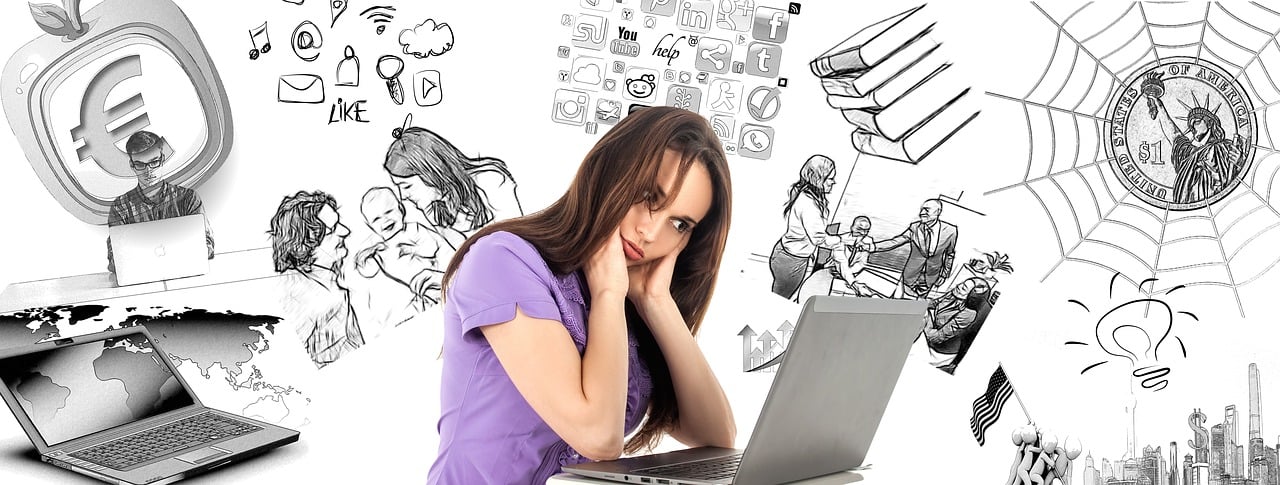
Imagine: it’s 9 pm on a weekday. You had a busy day at the office, filled with back-to-back meetings. Somehow you managed to scarf down some lunch in 10 minutes between meetings, which was a change from the norm of either eating during an online meeting with your camera off or skipping lunch altogether. Thank goodness for that. The last meeting of the day was running long, and you had to excuse yourself so you could race across town to pick up your child from daycare on time. You hate shirking work duties, but also feel guilty when your child is almost always the last one picked up every day. You thought dinner would be a breeze as you had planned to have burgers and fries (hooray for air fryers!), but alas, you forgot to pick up ketchup on the way home and well, fries just aren’t the same without it [insert meltdown by child, and some silent screaming by you as well]. Finally, the dishes are done, a load of laundry has been started, and your child is in bed.
You’re exhausted. You wish you could just curl up and go to bed as well, but you have a big report due in 5 days that you haven’t started, your dad has called you 3 times because he needs help fixing his computer, and you had promised to plan a social event for the daycare kids and parents. To top it off, you received a message today that your gym membership has lapsed due to inactivity…has it been that long? Clearly exercise has not been on your mind.
So, you pick up the phone to help your dad, and reluctantly turn on your computer to get cracking on that report, responding to a few messages from your co-workers who also happen to be online at this hour. You tell yourself that this level of busyness and stress is only temporary to get through this crunch, but in your heart you know that tomorrow, and the next day, and the next will be much of the same. If only there were 5 more hours in a day to get everything done…
 If you can relate to any of this, you’re not alone. Women have generally had to carry a heavy load, from having to work harder to prove themselves in the workplace, to expectations of being the primary caregiver for children and aging parents, to doing domestic chores that keep a household running. The pandemic exacerbated that, blurring the lines between work and home, with the ability to work from home being both a blessing and a curse in providing flexibility but also resulting in being constantly connected. You could be experiencing burnout.
If you can relate to any of this, you’re not alone. Women have generally had to carry a heavy load, from having to work harder to prove themselves in the workplace, to expectations of being the primary caregiver for children and aging parents, to doing domestic chores that keep a household running. The pandemic exacerbated that, blurring the lines between work and home, with the ability to work from home being both a blessing and a curse in providing flexibility but also resulting in being constantly connected. You could be experiencing burnout.
You don’t have to have all of this to experience burnout. Your burnout may look and feel entirely different, and burnout isn’t limited to only women or parents. The good news is it doesn’t have to be this way. By recognizing the signs of burnout and assessing what is draining you the most, you can proactively take steps to address and overcome them, improve your mental health and regain some work-life balance.
On May 21st, the Women in ITE Committee will be hosting a webinar called Beyond Bandages: Battling Burnout with Women in ITE, to hear personal stories of burnout and share ideas and strategies for avoiding or overcoming burnout. You’ll be able to connect with other transportation professionals in small group conversations to dive deeper into the topic and build a network of peers who can support you on this journey. Join us as we banish burnout and improve our mental health, together!
You Have Secured An Internship … But, Now What?
 As the summer months are quickly approaching, so will an influx of students as they enter the workforce through an internship position. Internships can provide valuable work experience, an opportunity to practice soft skills, and introduce many aspects of full-time employment while allowing students to explore their personal interests and form personal career goals. The Women in ITE Subcommittee wanted to be a resource for upcoming interns to hopefully ease the transition from student to employee and provide advice for those anxiously awaiting the opportunity to grow and excel in their potential field.
As the summer months are quickly approaching, so will an influx of students as they enter the workforce through an internship position. Internships can provide valuable work experience, an opportunity to practice soft skills, and introduce many aspects of full-time employment while allowing students to explore their personal interests and form personal career goals. The Women in ITE Subcommittee wanted to be a resource for upcoming interns to hopefully ease the transition from student to employee and provide advice for those anxiously awaiting the opportunity to grow and excel in their potential field.
Every company or organization will be different when it comes to an internship, as some may have a more formalized program with potentially hundreds of interns or the other side of the coin where you may be the sole intern at your company. There is not a one-size-fits-all scenario for an internship and at the end of the day, your experience will be what you make of it.
 If you are reading this post as an upcoming intern, we want to take a second to not only congratulate you for taking this exciting step in your career within the transportation industry, but also to reflect on what you have accomplished to get you to this point. You more than likely took the time to attend Career Fairs, have exceled in your classes, conducted research on companies to see if your interest(s) align, meticulously filled out applications, prepared for an interview, and interviewed for the internship position. You received word that you were selected for the position and enthusiastically returned your signed offer letter in anticipation for what the internship will hold… but, now what?
If you are reading this post as an upcoming intern, we want to take a second to not only congratulate you for taking this exciting step in your career within the transportation industry, but also to reflect on what you have accomplished to get you to this point. You more than likely took the time to attend Career Fairs, have exceled in your classes, conducted research on companies to see if your interest(s) align, meticulously filled out applications, prepared for an interview, and interviewed for the internship position. You received word that you were selected for the position and enthusiastically returned your signed offer letter in anticipation for what the internship will hold… but, now what?
Below is a compiled list of guidance and advice from prior interns who have since entered the workforce as full-time employees. We are optimistic that this list will leave you excited for your upcoming internship, eager for a challenge, and hopeful for your career in the transportation industry as we work together to improve the mobility and safety for all transportation system users and help build smart and livable communities!
- Don't just ask “how” to do things but also “why”. The technical work as an intern is typically developed and intended for you to understand and gain your bearings as you enter the workforce. Take this time to ask why something is done in a particular way, why certain decisions were made, or why a part of the project needs to be changed.
- Try not to be intimidated by all the information available. There is a lot that goes into a project, and you will not learn it all in one summer by any means. Do your best to get a feel for the project tasks, the overall project development process, and familiarize yourself with the resources and software programs utilized by your team.
- Ask questions. This sounds incredibly cliché, but the biggest piece of advice is to not be afraid to ask questions. Go the extra mile to find a solution on your own, when possible, to be able to ask an informed question but ask the question, nonetheless. Asking questions will allow you to practice your communication skills, demonstrate your problem-solving skills, and will show your employer that you are willing to learn… which is exactly why you are interning!
- Seek opportunities. Depending on the format of your internship program, you may be exposed to various types of work as an intern which is a really great way to maximize your intern experience. Take advantage of as many different components of the industry that you can be exposed to as this will help you weed out what you may like (and just as importantly, may not like) when it comes to your career interests and future path.
- Do not hesitate to say “Yes!”… as it will show that you are motivated, excited to learn, and will help illustrate your work ethic. Three months goes by so quickly, so try to prioritize the internship as best as possible!
- Take detailed notes. Taking good notes is a great way to make sure that you understand the task or project at hand, have a good grasp of what you need to do, and will prevent you from having to ask the same questions twice. It can be a struggle to keep up when you are first starting out as you are learning so much, being exposed to new terms and concepts, and adjusting to the work environment. Being able to reference your notes before, during, and after a project task will benefit you in the long run.
- It is okay to not know everything. Even the entry level engineers around you are still trying to figure it out. Do your part of being eager to learn, willing to make mistakes, and showing up every day with a positive attitude. Work on engaging with your coworkers to gain wisdom/insight about the job and the work you are doing.
- Leverage your differences. In the workplace, and in life, you will come across differences – leverage those as strengths rather than weaknesses. Bringing new insight and perspective to the table is so valuable in the workplace – whether it is your personality, hobbies, gender, ethnicity, nationality, disability, or just general upbringing/background that cause you to stand out, use that to your advantage and try to find ways to improve your team dynamic by leaning into who you are rather than trying to hide it.
- Make it a priority to get to know your coworkers and integrate yourself into your team and the company. Positive relationships with people in your field will pay dividends for you in the future. Everyone has a different skill set and a variety of experiences that you can learn from. Getting to know others around you can be helpful as you figure out what you are looking for from a career, develop personal goals for yourself, and what company you want to work for post-graduation.
- Develop strong relationships. Make friends in school and at the companies you intern at and do your best to keep in touch. You never know when you will need to fall back on your network to help you get a job, make a new hire, or team together to win a project.
- Apply what you are learning to your daily life. During your transportation internship, you may start to notice so many things in your day-to-day life that relate to the work or projects you are working on. For example, you may notice access management techniques along the busy corridor that your office is located off and realize that a traffic engineer may have recommended those elements to improve safety and reduce collisions on the route. Try to make it a habit to recognize the various aspects of the transportation industry throughout your day… you may be surprised at how many pieces of your life are connected to the internship work you are doing!
- Create good work/focus habits early on. These skills are difficult to teach and can help you stand out and become an asset to your company as well as make your work life more efficient and more enjoyable.
- Attend site visits. If you get the opportunity to see your project in the field, be sure to take advantage. Site visits will help you visualize and better understand the work you are doing in the office or learning in school and how that translates to the field.
- The technical knowledge will come… with time, exposure to projects/tasks, and practice, you will begin to develop the technical skills required of you within the industry. Try to not stress early on if a concept or skill is difficult to grasp at first.
- Be a sponge. An internship is a wonderful opportunity to absorb as much knowledge and information as you possibly can from your coworkers. Take the time to strengthen your technical skills, soft skills (such as communication, time management, problem-solving, teamwork, organization), and interpersonal skills. Use your time wisely, listen intently, and show up driven to seek and absorb all that you can during your internship.
Being an intern means that every single day is a new learning experience, and this opportunity ahead of you is a great personal commitment and step in your future within the transportation industry. We wish you the best of luck in your internship endeavor!
Ethics and Your License
 The fundamentals of the Engineers Code of Ethics include the following professional duties:
The fundamentals of the Engineers Code of Ethics include the following professional duties:
- Hold paramount the safety, health, and welfare of the public.
- Perform services only in areas of their competence.
- Issue public statements only in an objective and truthful manner.
- Act for each employer or client as faithful agents or trustees.
- Avoid deceptive acts.
- Conduct themselves honorably, responsibly, ethically, and lawfully so as to enhance the honor, reputation, and usefulness of the profession.
Engineers and Transportation Professionals are expected to perform all duties with honesty and integrity. Throughout our career, we will be faced with ethical, moral and legal dilemmas, our response is what matters. Use of critical thinking skills to determine pros and cons and the level of risk is very important. Understanding the Code of Ethics is vital. Disciplinary action can be taken against violations and while every state has different variations of regulations they still fall within the same code of conduct. The following are a few hypothetical situations that can be found on the NSPE website.
Situation 1 - Engineer A is under contract with the City to complete various assignments and is in the final year of their contract. The City Administrator coordinates the work of Engineer A, has been critical of their judgement on several occasions and will also be heavily involved in the effort to select the next consulting firm. The City Administrator also has previous experiences with a competing firm, Engineer B. The City Administrator contacts Engineer B to question him on specific issues Engineer A has worked on for the City. Engineer B knows that answering these questions in a certain perspective would give them an advantage in the next contract selection. Engineer B answers the City Administrator’s questions on the specific issues and is critical of Engineer A’s decisions. Is this ethical?
NSPE Code of Ethics Section III.6 states that Engineers shall not attempt to obtain employment or advancement or professional engagements by untruthfully criticizing other engineers, or by other improper or questionable methods. Engineer B’s conversation with the City Administrator could easily be seen as improper and questionable since, during the conversation with the City Administrator, Engineer B was not fully cognizant of Engineer A’s situation. 1
Situation 2 – Engineer C is a transportation engineer in the public sector and works for a state agency. The agency advertises for bids on signal upgrade projects; the bid documents made no reference to existing as-builts or drawings for the bidders’ or awarded contractor’s use. After bids are opened and contracts are awarded, the successful contractor asks Engineer C for as-built drawings of the existing signal. Engineer C provides the drawings. Over time, contractors who received as-built drawings from Engineer C in the past begin to ask for these documents when projects are advertised, before bids are turned in. Is it ethical for Engineer C to provide access to as-builts after projects were awarded? Is it ethical for Engineer C to share as-builts with contractors who ask for information during the bidding phase?
Acting as a faithful agent or trustee for a client or employer is an obligation for any engineer and is one of the fundamental canons in NSPE’s code of ethics. Engineer C’s efforts to make as-built drawings available for reference appears to be acting in the employer’s best interest. Providing more information about existing conditions should help produce a better design. Even so, informally sharing as-built information is troubling. Working through informal mechanisms on public projects can give the appearance of impropriety or favoritism. Engineer C can advise that as-built drawings are available, but should direct subcontractors to request them as part of the standard project process. Engineer C should not share documents on their own initiative or without formal permission. Because as-builts are useful and can help improve designs, Engineer C should initiate a process to include as-built drawings, when available, on projects going forward. It would be unethical for Engineer C to share as-builts with selected contractors pre-bid. 2
Below are several examples from actual disciplinary actions ranging from simple and innocent to blatant misconduct.
Example 1 – A Licensee signed, dated, and sealed engineering documents for the municipality that related to matters that were not prepared under the engineer’s responsible supervision, direction, or control. The Board imposed fines of $2,628 and ordered successful completion of a Board-approved course in basic engineering professionalism and ethics, and successful completion of the Board’s Study Guide.
Example 2 – Licensee issued statements in the practice of engineering that were misleading or tended to create a misleading impression and failed to act as faithful agent for their employers or clients. The Board imposed One Year Probated Suspension contingent upon successful completion of a Board-approved Ethics Basic Course, restitution in the amount of the retainer, and remittance of an Administrative Penalty of $2,500.
Example 3 - Licensee was charged with renewing their Professional Engineer license without having completed all required continuing education. Licensee renewed their Professional Engineer license without having completed the Area of Practice, Laws & Rules and Ethics courses on or before the deadline. These courses were not completed until after the deadline. The Board imposed fines of $565.
Example 4 - Respondent was charged with practicing engineering without a license, using the title “Professional Engineer” or other restricted title without a license, and presenting as their own the license of another. Respondent filed a set of engineering plans using the seal of a deceased Professional Engineer. The Board imposed fines of $5,300.
Many Professional Engineering Boards post the results of disciplinary actions as public information. To protect the integrity of our licenses we must continue to uphold and promote ethical conduct. Stay informed about your Board(s) Statutes, take refresher Laws and Ethics courses even if one is not required for license renewal, re-read and adhere to the Engineers Code of Ethics and actively promote ethical practices mentoring the next generation. Society places their trust in us and we should do everything in our power to maintain that trust!
- Review of Other Engineer’s Work | National Society of Professional Engineers (nspe.org)
- Sharing As-Built Drawings | National Society of Professional Engineers (nspe.org)
Age Is Just A Number, Until That Number Becomes Ageism
 What do you think when someone mentions discrimination? Often, we first think of race, color, religion, sex, sexual orientation, gender identity, national origin, or disability. It is highly unlikely that the first thing that comes to mind is “age”. However, according to the U.S. Equal Employment Opportunity Commission (EEOC), 21.1% of cases in 2022 cited “age” as a discrimination charge. Ageism, or the discrimination of individuals based on their age is more common among workers over the age of 40 but can affect younger employees as well. According to the EEOC, “The Age Discrimination in Employment Act (ADEA) forbids age discrimination against people who are age 40 or older. It does not protect workers under the age of 40 and it is not illegal for an employer to favor an older worker over a younger one, even if both workers are age 40 or older.”1
What do you think when someone mentions discrimination? Often, we first think of race, color, religion, sex, sexual orientation, gender identity, national origin, or disability. It is highly unlikely that the first thing that comes to mind is “age”. However, according to the U.S. Equal Employment Opportunity Commission (EEOC), 21.1% of cases in 2022 cited “age” as a discrimination charge. Ageism, or the discrimination of individuals based on their age is more common among workers over the age of 40 but can affect younger employees as well. According to the EEOC, “The Age Discrimination in Employment Act (ADEA) forbids age discrimination against people who are age 40 or older. It does not protect workers under the age of 40 and it is not illegal for an employer to favor an older worker over a younger one, even if both workers are age 40 or older.”1
 Ageism in the workplace can present itself as very subtle or very blatant. Usually, this affects employees at the two ends of the age group spectrum, such as hiring practices that favor hiring younger staff or promotions that overlook younger staff. Marginalization based on age occurs when an employee is excluded from critical work elements and their contributions begin to be undervalued. Although they may seem harmless, age-related jokes, talks of retirement, and demeaning tones are microaggressions that can have a significant impact over time and can also set the stage for larger acts of discrimination. A more obvious example of ageism is forced or encouraged retirement which can be identified through early retirement packages, restructuring, reducing responsibilities and reallocating assignments to younger employees.
Ageism in the workplace can present itself as very subtle or very blatant. Usually, this affects employees at the two ends of the age group spectrum, such as hiring practices that favor hiring younger staff or promotions that overlook younger staff. Marginalization based on age occurs when an employee is excluded from critical work elements and their contributions begin to be undervalued. Although they may seem harmless, age-related jokes, talks of retirement, and demeaning tones are microaggressions that can have a significant impact over time and can also set the stage for larger acts of discrimination. A more obvious example of ageism is forced or encouraged retirement which can be identified through early retirement packages, restructuring, reducing responsibilities and reallocating assignments to younger employees.
An American Psychological Association article in March 20232 discusses how ageism is considered socially acceptable. From “over the hill” parties, to gag gifts for turning certain ages, and a beauty industry obsessed with restoring youthful skin and anti-aging products, society perpetuates the negative stereotypes and ageism in general. Ageism has been so ingrained in our daily lives that we don’t even realize that it is harmful in other ways. According to the article, “People who take in more negative age beliefs tend to show worse physical, cognitive, and mental health.” These beliefs can then affect the workplace, family, and social interactions.
While society creates an acceptance of ageism, there can be several common myths that contribute to workplace discrimination. Employers may assume that older workers are closing in on retirement, they are not up to speed with the latest technology or skill sets required, they will demand higher salaries or that they are not willing to work under younger team members. These biases can cause an employer to lose out on valuable talent. In addition, there is a great need for the communication and soft skills that more seasoned employees possess.
On the flip side, younger workers can face ageism. Examples include being asked to work longer hours at a lower rate of pay, their input can be overlooked or dismissed, assumptions that they are lazy or that their tenure will be short. While these biases may not be as common, studies and polls indicate that younger employees believe they are missing out on opportunities due to ageism.
Additionally, the impact of ageism on women specifically can be significant at all ages. A recent Harvard Business Review article3 describes how it often feels like there is no right age for professional women, and women in leadership roles often face ageism no matter what their age is. Young women can be called pet names, be mistaken for students/interns and must frequently prove themselves to gain credibility. Middle aged women can be overlooked based on assumptions that they “have too many family responsibilities” and may be “difficult to manage due to menopause issues”. And older women may not be seen as relevant or able to advance any further in their careers. It’s important to consider the highly gendered impacts of ageism in the workplace and the relation to looks/appearance that is more widely felt by women.
Age discrimination is illegal at all stages of employment, from hiring to promotions to layoffs. However, it is legal for an employer to ask your age and/or graduation date, unless prohibited by state law. In 2009, the Supreme Court ruled that proof of age discrimination must meet a higher burden of proof than other forms of discrimination. There are a lot of rules about what is acceptable and what is not acceptable, it is not straight forward. For example, involuntary retirement can be required for executives and when public safety is in danger. We encourage you to know your rights and reach out to experts if you need assistance (https://www.workplacefairness.org/age-discrimination/).
There are many things that can be done to prevent ageism in the workplace. Employers can create a collaborative environment by creating opportunities for multigenerational interactions, develop cross generational mentor programs, provide benefits and development opportunities for all ages, reviewing HR processes and raising awareness. The biggest impact each of us can have is to change our own narrative about age and ageing, participate and advocate for multi-generational interaction and finally be an advocate for inclusion.
No matter what your age, consider this quote by author Cindy McDonald “Aging is not an option, not for anyone. It is how gracefully we handle the process and how lucky we are, as the process handles us.”
1 https://www.eeoc.gov/age-discrimination
3 https://hbr.org/2023/06/women-in-leadership-face-ageism-at-every-age
Transforming Awareness to Action: Fighting to End Human Trafficking
By Jodi Godfrey and Lexi Higgins
 The scent of the morning dew, mild and humid is a familiar feeling in her nostrils as she wakes and realizes that her nightmares were not a dream at all, but rather she was living her idea of hell. Just a few days prior, frustrated with rules that her parents instilled, she packed a few outfits, a toothbrush and hairbrush, a little makeup, you know, the essentials for a teenage girl, and she ran away in the middle of the night. With no real idea of where she would go, she ended up at the local transit bus transfer center, and realized that she could probably get away with sleeping there. It was cold and fights broke out every now and then, but she didn’t know where else to go. That’s when her trafficker approached her, offering a meal and a place to stay, posing as a safe friend who understood her in a way her parents didn’t.
The scent of the morning dew, mild and humid is a familiar feeling in her nostrils as she wakes and realizes that her nightmares were not a dream at all, but rather she was living her idea of hell. Just a few days prior, frustrated with rules that her parents instilled, she packed a few outfits, a toothbrush and hairbrush, a little makeup, you know, the essentials for a teenage girl, and she ran away in the middle of the night. With no real idea of where she would go, she ended up at the local transit bus transfer center, and realized that she could probably get away with sleeping there. It was cold and fights broke out every now and then, but she didn’t know where else to go. That’s when her trafficker approached her, offering a meal and a place to stay, posing as a safe friend who understood her in a way her parents didn’t.
This scenario, while not extreme, is also not uncommon, and is likely playing out in every city, town, or community that you can think of (yes, even your own) on a regular basis. It is also a quintessential example of what human trafficking can look like in our communities.
 Human traffickers don’t necessarily look like the ‘Bad Guy.’ Often traffickers lure their victims into exploitative situations by treating them with affection and attention. Traffickers look for the signs of vulnerability, and they capitalize on that vulnerability to ensure the victim performs as desired through force, fraud, and coercion. Often traffickers will act like they are romantically interested in their victims, to gain their trust and information that can then be used to ensure that the victim does not easily escape. That trauma bond that is often formed is one of the many reasons that it is so difficult to put an end to human trafficking all together.
Human traffickers don’t necessarily look like the ‘Bad Guy.’ Often traffickers lure their victims into exploitative situations by treating them with affection and attention. Traffickers look for the signs of vulnerability, and they capitalize on that vulnerability to ensure the victim performs as desired through force, fraud, and coercion. Often traffickers will act like they are romantically interested in their victims, to gain their trust and information that can then be used to ensure that the victim does not easily escape. That trauma bond that is often formed is one of the many reasons that it is so difficult to put an end to human trafficking all together.
To start the conversation, it is important that the definition of human trafficking is understood. The U.S. Department of Justice defines human trafficking as a crime that involves the exploitation of a person for labor, services, or commercial sex. This includes two primary forms of trafficking: Labor trafficking, which is the recruitment, harboring, transportation, provision, or obtaining of a person for labor or services, through the use of force, fraud, or coercion for the purpose of subjection to involuntary servitude, peonage, debt bondage, or slavery. And sex trafficking, which is the recruitment, harboring, transportation, provision, obtaining, patronizing, or soliciting of a person for commercial sex induced by force, fraud, or coercion, or in which the person induced to perform such act is under 18. This age minimum is important, because it means that any minor engaged in commercial sex is considered a victim of human trafficking. Consent is not possible prior to 18 years of age. Additionally, prior to adulthood, the part of the brain that is responsible for rational thinking and connecting consequences with choices, the prefrontal cortex, has not yet fully developed.
You may be thinking that human trafficking has nothing to do with your work, or daily life. This issue can feel dark and overwhelming, and often leaves people thinking, ‘Okay, but what can I do?’ The truth is, everyone has a role to play in the fight against human trafficking. And, as a member of the transportation industry, you may even have potential for more impact than others. Here are three things you can do right now:
1. Get informed. The most important thing you can do is learn more about the realities of human trafficking and how to recognize it. Some signs of trafficking could include:
- Persons offering to exchange sex for money, goods or services, especially if it appears to be a minor
- Persons who acknowledge having a pimp, ‘sugar daddy,’ or needing to make a quota
- Minors traveling without adult supervision, especially if they don’t know the person they are traveling to meet
- Persons who are not allowed to speak for themselves or make eye contact
- Persons with bruising, branding, or physical trauma
- Persons who look dirty, disheveled, seem confused, panicked, or afraid
- Passengers whose tickets, money, identification, phone, or movements are controlled by another person
Truckers Against Trafficking (TAT) offers free, industry-specific training for the transportation industry about human trafficking. In less than an hour, you can complete an online course to learn more about the issue and how you can play a role in fighting it. TAT believes that the transportation industry, from trucking to transit, is uniquely positioned to combat human trafficking as they are literally eyes and ears on the ground across the country. In addition to online training for individuals, TAT offers free plug-and-play training materials to transportation companies and agencies to train their staff, and recently released a response protocol template for transit agencies.
2. Report suspected trafficking. If you do recognize a potential human trafficking situation, you are encouraged to call local law enforcement and/or report the details of the event to the National Human Trafficking Hotline (NHTH) at (888) 373-7888. The NHTH connects victims of trafficking to resources near them.
Never confront a potential trafficker or intervene directly. Approaching traffickers is not only dangerous for you and their victims, it can also affect prosecution for their crimes down the road. Instead, if a situation is recognized, it is best to remember key characteristics that may help to identify the people involved at a later time. For example, take note of physical characteristics of the people and vehicles, including details such as license plate numbers and overheard nicknames as examples. If you happen to encounter a potential victim that is not with their trafficker, you are encouraged to ask simple questions like, “Are you okay?” or “Can I call someone for you?” because asking if they are a victim of human trafficking will likely not be well received.
A great resource to carry with you should the situation ever arise is the new TAT app, which received a complete makeover for 2024. The app now includes location-based recommendations for local hotlines and service providers, as well as a searchable list of indicators that can help you determine if what you’re seeing could be human trafficking.
3. Share information with your network. The more eyes and ears we have in our communities that are aware of this issue, the better equipped we will be to fight it. Share TAT’s free resources with your contacts in the transportation industry. You can also follow/share our posts on social media. Finally, we encourage you to talk to your families and children about this issue.
There are topics in life that no one seems to want to talk about because they make us feel uncomfortable; most of us would prefer to pretend like these things only happen in the movies. Unfortunately, that is not reality. In reality, it is important that we do talk about these topics so that we can play a role in making change. Whether we want to admit it or not, human trafficking is happening in nearly every city, every town, every community, and yours is no exception. Victims are likely being trafficked in your neighborhood, without you even realizing the activity is taking place.
The good news is, we can all play a role in ending this heinous crime. At the end of the day, the ultimate goal is to train everyone in our communities to recognize the signs of human trafficking so that it cannot continue to occur in plain sight. We can work together to recognize and report these crimes, and to minimize them from happening in the future. Together we can join forces to fight against human trafficking.
Navigating the Season with Cheers: Holiday Drink Inspirations from WITE
With the holidays right around the corner, celebrating with family and friends can be so much fun! However, just one alcoholic (aka Fully Leaded) beverage can affect a person’s driving. The importance of planning ahead and having a designated driver (DD) is critical for the safety of the vehicles passengers as well as the public at large. But even a DD wants to have a special holiday drink (aka Unleaded). Plan ahead by creating fun drinks for everyone! We have compiled a few WITE favorites of Unleaded drinks safe to take on the road and Fully Leaded drinks to enjoy at home.
 Unleaded Beverages (Designated Driver Safe)
Unleaded Beverages (Designated Driver Safe)
 Rosemary Greyhound Spritzer (made in batch)
Rosemary Greyhound Spritzer (made in batch)
Ingredients
- 1/2 cup water
- 1/2 cup sugar
- 1 sprig rosemary
- 2 cups seltzer
- 4 cups grapefruit juice
- crushed ice for serving
- rosemary sprigs and grapefruit slices for garnish (optional)
Instructions
- To make the rosemary simple syrup, heat the water (1/2 cup) and sugar (1/2 cup) together in a small pot. Don't bring it to a boil- just heat until the sugar is completely dissolved. Remove from heat and add the rosemary sprig. Allow to steep for 20 minutes to an hour. Remove rosemary stem and discard.
- Combine the rosemary simple syrup, seltzer (2 cups), and grapefruit juice (4 cups) in a pitcher. Stir together and chill.
- Before serving, stir together one more time. Serve over crushed ice in old fashioned glasses and garnish with fresh grapefruit slices and rosemary sprigs, if desired.
Pear & Rose Punch
Ingredients
- 1L pear juice
- 1 vanilla pod
- 1 tbsp golden caster sugar
- 4 cardamom pods
- few slices root ginger
- 25ml raw apple cider vinegar
- ½ tsp rosewater
- 250ml sparkling water
- ice
For the garnish
- rosemary sprigs
- thyme, leaves picked
- sliced red pear
- handful frozen redcurrants
Instructions
- Pour the pear juice into a large pan. Add the vanilla pod, golden caster sugar, cardamom pods and root ginger, then bring to a simmer. Leave to cool completely, then strain into a punch bowl or jug.
- Add the raw apple cider vinegar, rosewater and sparkling water. Garnish with rosemary sprigs, thyme, sliced red pear and a handful of frozen redcurrants. Add ice and serve.
Paradise City
Ingredients
- 0.5 oz vanilla syrup
- 0.5 oz passion-fruit puree
- 1 oz grapefruit juice
- 1 oz cream
- 2 oz club soda
Instructions
- Combine vanilla syrup, passion-fruit puree, grapefruit juice, and cream in a cocktail shaker over ice.
- Pour club soda into a highball glass, then slowly strain the contents of the cocktail shaker over the club soda, allowing the head of foam to rise above the rim of the glass.
Non-Alcoholic Hot Buttered Rum
Ingredients
- 1/2 cup butter, softened
- 1 cup dark brown sugar
- 1 cup Monk Fruit In The Raw bakers bag (or 24 packets of Monk Fruit In The Raw)
- 1 teaspoon ground cinnamon
- 1/2 teaspoon ground nutmeg
- 1/8 teaspoon ground cardamom
- 1/16 teaspoon ground cloves
- Boiling water
- Half and half or heavy cream
Instructions
- Combine the butter, sugar, Monk Fruit In The Raw, cinnamon, nutmeg, cardamom, and cloves in a mixing bowl.
- Beat with an electric mixer until thoroughly combined.
- Use immediately, or transfer to an airtight container and refrigerate until ready to use.
- To make each drink, scoop 1 1/2-2 tablespoons of the buttered spice mixture into a small mug.
- Pour 1/4 cup of boiling hot water into the cup and stir or whisk to dissolve completely.
- Add 1-2 tablespoons of half and half or cream, and stir once more.
- Taste, add more water or cream, as desired.
Apple Barley Old Fashioned
Ingredients
- 1 oz strong-brewed chilled barley tea bag (poured from 10 oz of hot water brewed with two tea bags)
- 1/3 dropper Angostura bitters
- 5 dashes molasses bitters
- 0.25 oz simple syrup
- 0.5 oz apple cider
- Splash of club soda – optional
Instructions
- Stir ingredients and garnish with an orange swath and two Luxardo cherries.
Cider, Thyme + Tonic Mocktail
Ingredients
- 12 oz apple cider
- 2 oz freshly squeezed lemon juice
- 2 oz thyme simple syrup*
- 1 bottle (9.3 ounces) tonic water
- Additional thyme and lemon slices for garnish
Thyme Simple Syrup
- 0.5 cup granulated sugar
- 0.5 cup water
- 2-3 sprigs of fresh thyme
Instructions for Thyme Simple Syrup
- Add all ingredients to a small saucepan.
- Turn heat to low and stir until sugar dissolves.
- Simmer an additional 5 minutes, or until syrup coats the back of a spoon.
- Remove from heat.
- Take out the thyme sprigs and allow syrup to cool completely before using.
- Store leftover syrup in a jar in the fridge for up to 2-3 weeks.
Instructions for Mocktail
- Add all ingredients except tonic water to a pitcher and stir until fully incorporated.
- Add ice to four glasses, filling each about halfway.
- Divide the cider mixture evenly among the glasses.
- Top with tonic water.
- Stir gently.
- Garnish with a sprig of thyme and enjoy!
The Classic Shirley Temple
Ingredients
- Ice
- 1 (12 ounce) bottle Grenadine (see note 1)
- 1 (2 Liter) bottle lemon-lime soda (see note 2)
- Maraschino cherries for garnish, optional
Instructions
- Fill a glass with ice.
- Add 1 ounce (2 tbsp) grenadine, then top with 8 ounces lemon-lime soda.
- Garnish with maraschino cherries if desired
**Alternative Roy Rogers: Substitute Coca-Cola for the Sprite.
Masala Chai Tea
I love making it in the winter months with ginger, fenugreek, and cardamom...tastes heavenly! It's great alongside samosas (savory pastry with spiced potatoes/peas) and jalebis (warm dessert) as an evening snack.
Method 1 (Instant Masala Chai Powder) - Ingredients
- 4 green cardamoms
- 2-3 cloves
- 1/2 - 3/4 inch piece of cinnamon
- 2 pepper corn
Method 2 (Masala Chai Powder) - Ingredients
- 1 tsp green cardamom
- 1/2 tsp cloves
- 2 1/2-3 grams cinnamon
- 1/4 tsp fennel seeds
- 1/4 - 1/2 tsp black pepper corn
- 1/2 tsp nutmeg
- 2 petals star flowers
Instructions for Making Tea
- 1 1/2 - 1 3/4 cups water
- 1 cup full fat milk
- 2 1/2 - 3 1/2 tsp black tea leaves
- 2 -3 tsp sugar
- 1/2 - 3/4 tsp ginger
Instructions for Method 1
- Add cloves, cardamon, cinnamon sticks, and black pepper to a mortar pestle or a spice grinder. Crush or grind them into a powder.
- Pour water into a pot. Add the tea, ground spices, and crushed/chopped ginger. (Start with a lower amount of tea and increase after adding milk.)
- Bring to a rolling boil and reduce heat to medium. Boil for three minutes until concoction turns dark.
- Pour milk and add sugar. Bring to a boil on medium high heat. (If you are using tea bag, remove them and keep to the side).
- Reduce the heat and simmer until the chai (tea) becomes dark (3-4 minutes). Simmer until tea reduces to 1 1/4 cups.
- The tea is ready, there is a layer of cream on top and the milk flavor is gone.
- Optionally, aerate or pull your masala chai for the same Chaiwallah taste. Take a soup ladle and aerate the masala chai or simply pour some chai into a measuring cup. Pour the hot tea in a slow stream, back to the chai pot from a height of 1 1/2 to 2 feet.
- Repeat this step of pulling hot masala chai from the pot to the cup, 4 to 5 times. This will break down the layer of cream and incorporates it back to the masala tea, making it tasty and thick.
- Strain the masala chai into serving cups and serve with breakfast, snack, or biscuit.
Instructions for Method 2
- Clean all the spices and add to a blender jar. Powder finely. Store it in an airtight glass jar.
- Use about 1/2 - 3/4 tsp to make two servings of tea.
 Fully Leaded Beverages (Hand Over the Keys Please)
Fully Leaded Beverages (Hand Over the Keys Please)
 Tom & Jerry
Tom & Jerry
Ingredients:
- 2 eggs, separated
- 1/2 lb. powdered sugar
- Hot milk
- Brandy or rum (optional)
Instructions
- Separate 2 eggs, beat egg whites until stiff.
- Beat egg yolks, add powdered sugar to yolks and beat again.
- Then fold in egg whites.
- To each cup add: 1 tbsp. batter, 3/4 cup hot milk, 1 jigger Brandy or Rum (optional). Enjoy!
New Years Eve Toast
Ingredients:
- Glass of dry champagne
- A splash of pomegranate juice
- A sprig of rosemary
Rosemary Greyhound Cocktail (made in batch)
Ingredients
- 1/2 cup water
- 1/2 cup sugar
- 1 sprig rosemary
- 2 cups vodka, tequila or gin
- 4 cups grapefruit juice
- crushed ice for serving
- seltzer water optional
- rosemary sprigs and grapefruit slices for garnish (optional)
Instructions
- To make the rosemary simple syrup, heat the water (1/2 cup) and sugar (1/2 cup) together in a small pot. Don't bring it to a boil- just heat until the sugar is completely dissolved. Remove from heat and add the rosemary sprig. Allow to steep for 20 minutes to an hour. Remove rosemary stem and discard.
- Combine the rosemary simple syrup, vodka (2 cups), and grapefruit juice (4 cups) in a pitcher. Stir together and chill.
- Before serving, stir together one more time. Serve over crushed ice in old fashioned glasses and garnish with fresh grapefruit slices and rosemary sprigs, if desired. Top with a little bit of seltzer water for some fizz, if desired.
Cranberry Margarita
Ingredients
- 1.5 oz cranberry Juice
- 1 oz fresh lime juice
- 1.5 oz Casamigos Blanco tequila
- .5 oz Cointreau (optional)
- .25 oz agave syrup
- Fresh cranberries and lime for garnish
Instructions
- Salt or sugar the rim (optional). Run a lime wedge (the juicy part) around the top rim of your serving glass. Fill a shallow bowl or plate with salt or sugar, then dip the rim until it is covered. Set aside.
- Make the margarita mix. Add ingredients and a few ice cubes to a cocktail shaker. Cover and shake vigorously for about 10 seconds.
- Fill the prepared serving glass with ice. Strain in the margarita mix, garnish, serve and enjoy.
Hugo Spritz
We fell in love with this drink on vacation a few years ago after trying (valiantly) to get into the Italian Aperitif and finding the Aperol and Venetian Spritzes too bitter. But everyone in the group loved the Hugo - and now we make it at home all the time! It's very refreshing and obviously a great drink during warm weather - but also a nice balance to heavy meals during cooler months... and a great way to dream of vacations!
Ingredients
- 1 sprig of mint
- 1-2 slices of lime (lemon works too in a pinch)
- 1.5 oz. elderflower liqueur or syrup (you can find St. Germain in many places - even Target!)
- 3 oz. prosecco
- 1 oz. soda/sparkling water
- ice
Instructions
- Add mint and elderflower liqueur in a glass; stir or muddle gently (add a slice of lime during this step if desired)
- Add ice (to the top!), then pour in prosecco & a splash-ish of soda water
- Stir to combine and top with lime slice and additional mint
Holiday Sangria
Ingredients
- 1 (750 ml) Bottle red wine
- 1 cup Brandy
- 1/4 cup Sugar
- 2 cups Cranberries
- 1 Orange, sliced
- 1 Apple, cubed
- 2-3 Cinnamon sticks
- 4 Star anise
- 4 Sprigs rosemary, plus more for garnish
- 1 Bottle sparkling apple cider, chilled
- Equal parts cinnamon and sugar, for rimming the glasses, optional
- Maple syrup or honey for rimming the glasses, optional
Instructions
- In a large pitcher (or punch bowl) combine the red wine, brandy, sugar, cranberries, oranges, apples, cinnamon sticks, star anise and rosemary. Mix well, cover and place in the refrigerator overnight to allow flavors to come together.
- Just before serving add the sparkling apple cider, stir to combine. Serve over ice, in a glass rimmed** with a mix of cinnamon and sugar, garnished with fresh rosemary sprigs.
- If you’d like to serve this sangria in a glass rimmed with cinnamon-spiked sugar, here’s how.
- Mix equal parts cinnamon and sugar together in a small and spread it out evenly on a small plate.
- On a second small plate, pour out some maple syrup or honey.
- Dip the edge of your glass in the honey or syrup and then press the rim of your glass into the sugar mixture.
- Fill the glass with ice and carefully pour the sangria without hitting the side of the glass, garnish with rosemary and serve.
Pomegranate Martini
Ingredients
- 1 tbsp. sanding sugar
- 1 lemon, halved
- Ice
- 2 oz. fresh pomegranate juice
- 1 1/2 oz. vodka
- 1/2 oz. Cointreau
- 1/2 oz. fresh lemon juice
- Pomegranate seeds and rosemary sprig, for serving
Instructions
- Place a martini glass in the freezer for 15 minutes, if desired.
- Place sanding sugar on a shallow plate. Rub a lemon half around rim of martini glass, then dip into sugar.
- Fill a cocktail shaker with ice. Add pomegranate juice, vodka, Cointreau, and lemon juice and vigorously shake until outside of shaker is frosty, about 20 seconds.
- Strain into prepared glass. Garnish with pomegranate seeds and rosemary sprig.
Moscow Mule
Ingredients
- Ice cubes
- 1 lime
- ½ cup vodka
- 1 bottle or can ginger beer
- 2 lime wedges for garnish
Instructions
- Fill the mugs or glasses with ice.
- Juice the lime to get about 2 tablespoons (1 for each glass).
- Add the vodka to each glass.
- Divide the ginger beer between the glasses, pouring about ¾ cup into each drink.
- Stir gently to combine and serve with garnished lime wedge.
Please drink responsibly and consider these sober ride services over the holiday season:
- Lyft (https://www.lyft.com/)
- Uber (https://www.uber.com/)
- Dryver (https://www.dryver.com/)
- Free mobile app in the App Store and Google Play. This personal driver service has three options to choose from. Rates vary depending on the kind of service you need, ranging from a $25 fee plus mileage to an hourly rate beginning at $15.95 to $53.
- Operation Red Nose (https://www.operationnezrouge.com/en/)